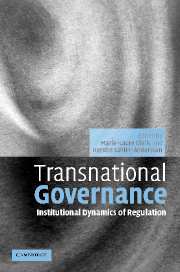Book contents
- Frontmatter
- Contents
- List of figures
- List of tables
- List of contributors
- Acknowledgments
- List of acronyms
- 1 Introduction: A world of governance: The rise of transnational regulation
- I Institutional forces
- II A dynamic transnational topography
- III Transnational governance in the making
- 12 Dynamics of soft regulations
- 13 Contested rules and shifting boundaries: International standard-setting in accounting
- 14 The international competition network: Moving towards transnational governance
- 15 The emergence of a European regulatory field of management education
- 16 Market creation and transnational rule-making: The case of CO2 emissions trading
- 17 Transnational NGO certification programs as new regulatory forms: Lessons from the forestry sector
- 18 Institutional dynamics in a re-ordering world
- References
- Index
16 - Market creation and transnational rule-making: The case of CO2 emissions trading
Published online by Cambridge University Press: 22 September 2009
- Frontmatter
- Contents
- List of figures
- List of tables
- List of contributors
- Acknowledgments
- List of acronyms
- 1 Introduction: A world of governance: The rise of transnational regulation
- I Institutional forces
- II A dynamic transnational topography
- III Transnational governance in the making
- 12 Dynamics of soft regulations
- 13 Contested rules and shifting boundaries: International standard-setting in accounting
- 14 The international competition network: Moving towards transnational governance
- 15 The emergence of a European regulatory field of management education
- 16 Market creation and transnational rule-making: The case of CO2 emissions trading
- 17 Transnational NGO certification programs as new regulatory forms: Lessons from the forestry sector
- 18 Institutional dynamics in a re-ordering world
- References
- Index
Summary
Introduction
Many have celebrated the creation of pollution markets as the triumph of markets over states. Along with a general move towards marketbased approaches in environmental regulation and other fields of public policy (see Djelic ch. 3), successful examples of these new markets can be cited, including the creation of pollution rights, resource use quotas, and credits for reducing environmental impacts (Daily and Ellison 2002). The most prominent example is the so-called Acid Rain Program introduced by the United States in the 1990s to reduce the country's overall SO2 (sulfur dioxide) emissions (Ellerman et al. 2000). These developments have been grist to the mill for advocates of the free market who criticize government intervention for its inefficiencies and the distortions it creates.
From the perspective of advocates of the free market, environmental pollution or overuse of natural resources occur when property rights over the environment or natural resources do not exist or are poorly enforced. Prices then do not adequately reflect the scarcity of a resource or the damage to an environmental good, and consequently produce market failures. Thus, to avoid pollution and overuse, property rights must (and can) be established and enforced, and the transfer of those rights should be allowed, thus creating a market in which undistorted price signals emerge. The market is thereby seen as the solution to environmental problems, whereas regulation would only create more distortions (Anderson and Leal 1991, 1997).
- Type
- Chapter
- Information
- Transnational GovernanceInstitutional Dynamics of Regulation, pp. 329 - 348Publisher: Cambridge University PressPrint publication year: 2006
- 24
- Cited by



